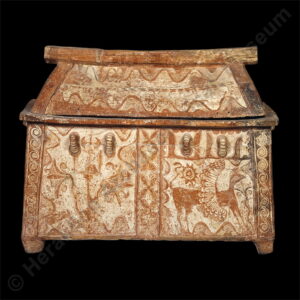
Larnakes are large chest-shaped or bathtub-shaped vessels with slab or gabled lids, mainly used as sarcophagi. In Postpalatial Crete (1300-1100 BC), the clay larnakes used for the inhumation of the illustrious dead were often richly decorated with symbolic themes, usually depicting the ceremonial journey of the dead and the presence of the goddess, who rules not only the world of the living but also the world of the dead. The clay chest larnax type appears to imitate wooden structures, as we see from the rendition in clay of structural elements such as the horizontal lid beam and the side panels. Special mention must be made of the stone Agia Triada Sarcophagus, with rich painted decoration on a thin plaster coating in the fresco technique. Its iconography provides important information on the complex burial rites in honour of the dead. In the historical era, the marble sarcophagi of the Roman period are imposing artefacts, often featuring elaborate carved decoration.